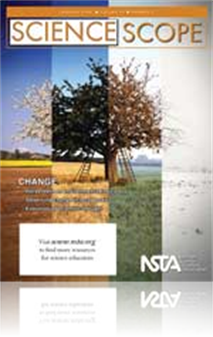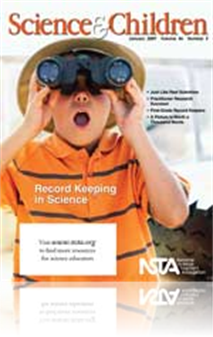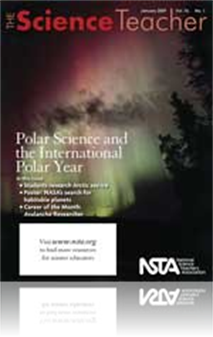All Resources
Journal Article
Through a project funded by the National Science Foundation, Horizon Research has been developing assessment items for students (in the process, compiling item-writing principles from several sources and adding their own). In this article, the author...
Journal Article
Today, the majority of the leadership among science educators of all levels recognizes that inquiry learning is necessary to build this basis for everyone. Lectures on the dry facts of nomenclature can’t compete with the effectiveness of a well-con...
Journal Article
A Picture Is Worth a Thousand Words
Lions, tigers, and bears, oh my! Digital cameras, young inquisitive scientists, give it a try! In this project, students create an open-ended question for investigation, capture and record their observations—data—with digital cameras, and create ...
Journal Article
This paper address three questions apropos of those posed by Kadel (2006) in the context of a large introductory-level undergraduate science lecture course. These questions include how podcasting is used by professors and students, whether podcastin...
Journal Article
The Landsat Image Mosaic of Antarctica (LIMA)
By studying Antarctica via satellite and through ground-truthing research, we can learn where the ice is melting and why. The Landsat Image Mosaic of Antarctica (LIMA), a new and cutting-edge way for scientists, researchers, educators, students, and ...
Journal Article
An institution-wide focus on deep learning has made significant changes in the biology and physics core course curriculum at the U.S. Air Force Academy. The biology course director has reworked course objectives to reflect the learning-focused approa...
Journal Article
The Prepared Practitioner: Understanding Heat and Temperature
Since this issue of The Science Teacher has a polar theme, the author thought this would be a particularly appropriate time to examine research about students’ preconceived ideas about heat—or the lack thereof. Heat and temperature are difficult,...
Journal Article
Idea Bank: Celebrate the International Year of Astronomy
In 1609, Galileo Galilei turned his telescope to the night sky and began a series of observations of the cosmos. These observations, together with the work of Johannes Kepler and other scientists of the time, revolutionized our understanding of the u...
Journal Article
Science Sampler: Exploratory Excursions—Documenting slow changes in local parks
While hiking a local conservation property and trying to unwind after a hectic day, it dawned on the author that teaching his students about slow changes to the Earth’s surface could be as simple as a walk in the woods. Decaying stumps, ATV tracks,...
Journal Article
Many teachers fall into the pattern of “assumptive teaching” (Herber 1970), assuming that other instructors will teach students the important strategies they need for learning. In this case, tools and strategies may not be taught outside of readi...
Journal Article
Practitioner Research Success!
Practitioner research is an ongoing, reflective process in which inservice teachers (i.e., practitioners) ask questions about their day-to-day teaching practice, develop plans of action to investigate these questions, draw conclusions supported by ev...
Journal Article
Is Earth unique in the universe? What is a habitable planet? How abundant are habitable planets? NASA’s Kepler Mission team seeks answers to these questions. Launching in 2009, Kepler is NASA’s first mission capable of finding Earth-sized and sma...
Book Chapter
How Assessment and Testing Developed
The United States has approximately 55 million students in grades K–12. On average, teachers administer 100 teacher-generated tests per school year, which translates into America’s students taking approximately 550 million—that’s 550,000,000�...
Book Chapter
An old saying goes, “The only constant is change.” No truer words have ever been spoken, especially in a time of reform. As a matter of fact, reform is change. This chapter examines change from two perspectives. The first perspective examines the...
Book Chapter
The Role of Curriculum Materials in Reform
Distinguishing between standards-based curriculum materials and others requires considerable expertise in science content and pedagogy. Research suggests that even experienced teachers may not recognize how standards-based instruction can be embodied...
Book Chapter
Learning From Innovative Instructional Materials and Making Them Your Own
This chapter examines the interplay between the intended implementation of designed, innovative instructional materials and the enacted curriculum by teachers who are accustomed to customizing their own instruction. When the Education Development Cen...
Book Chapter
Building Leadership Teams to Create Professional Learning Communities in Secondary Schools
This chapter proposes one way to foster teamwork and develop a professional learning community at the secondary level by describing the development of a leadership team focused on improving science teaching and learning. Forming a leadership team is ...
Book Chapter
Essential Partnerships in the Reform of Secondary Science
Alice’s travel through Wonderland resembles our journeys with reform. We often encounter new experiences. We learn from events. Some tasks are harder to complete than they initially appear. Moreover, we tend to encounter the same lively characters ...
Book Chapter
Using Data to Reform Science Instruction
This chapter will introduce you to skills and strategies used to examine classroom assessment data to improve science instruction. Although the authors advocate using multiple forms of student work to inform instruction, they will focus on using stud...
Book Chapter
Appropriate Practice for Linguistically Diverse Science Learners
The population of the United States continues to become increasingly diverse, both culturally and linguistically. In less than two decades, one half of the students in the United States will be non-white and Latino, with one quarter of the total stud...
Book Chapter
One Teacher’s Journey Toward Reformed Teaching
Reform requires us to rethink our teaching, to view teaching through different eyes. Such change requires professional development experiences that are long term and sustained. The experiences must challenge teachers to consider new ways of thinking ...
Journal Article
To form and orchestrate intelligent groups is a real challenge for 21st-century education and research. In this paper the authors show how a regional state university was able to facilitate interdisciplinary research and education through forming an ...
Journal Article
The Early Years: What Sort of Feather?
What do feathers have to do with flying? How is a feather like a hair? Do all feathers look the same or serve the same purpose? What does a feather look like inside? These are the type of open-ended questions to explore with your students as they han...
Journal Article
Methods and Strategies: Enhancing Science for ELLs
The elementary classroom is changing, and English Language Learners (ELLs) are frequently a part of the mainstream classroom, learning alongside of native English speaking children, even when the ELLs’ language has not yet developed fully. So, teac...








